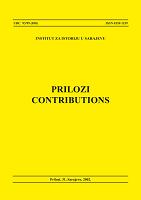Diplomatičko-paleografska analiza Bolinopoilske isprave iz 1203. godine
Diplomatic and Paleographic Analysis of Bolinopila Declaration Dating From 1203
Author(s): Milko BrkovicSubject(s): History
Published by: Institut za istoriju
Keywords: Bilinopila Declaration; paleographic analysis
Summary/Abstract: This document contains conventional parts such as the declarations issued by the Central European medieval offices. It contains the introduction or the protocol, then the text, the context or rather the corpus and then the conclusion or eschatocol. Within these three major units or major segments, there are basic diplomatic formulas or the integral parts of the declaration. Thus the protocol contains the formulas of date and title, the corpus contains the formula of narration and disposition, and the eschatocol has the formula of the witness, corroboration, oath, and completion. Relating the earlier neighboring offices, this declaration’s structure is closest to the structure of the declaration issued by the medieval office of the Croatian popular rulers, and of the contemporary offices it is closest tot he structure of the medieval Bosnian declaration issued by the Ban. A brief diplomatic and paleographic analysis of the three dates of Bolinopoila declaration (Actum apud Bosnam iuxta flumen loco qui vocatur Bolino Poili) from our viewpoint is the following: Actum apud Bosnam is the integral part of the topographical or geographical date. This term in the declarations always derives from the name of the settlement in which the legal document was written. In our case, it was done in near the town of Bosna in the monastery (loco) called Bolino Poilo or perhaps Bolina Poila. With numerous examples in the documents, whose enumeration would take too much space, the same term actum is used again at the end of the same Bolinopoila declaration, and the meaning is identical (Actum in Insula Regia). The only difference is that above it is apud and here it is in. Luxta flumen excludes the preposition apud and undoubtedly denotes the vicinity of a river, most probably the River Bosna, but it is not excluded that it could also be a small river near the town of Bosna, or Visoko as it is now called.
Journal: Prilozi
- Issue Year: 2003
- Issue No: 32
- Page Range: 49-74
- Page Count: 26
- Language: Croatian

